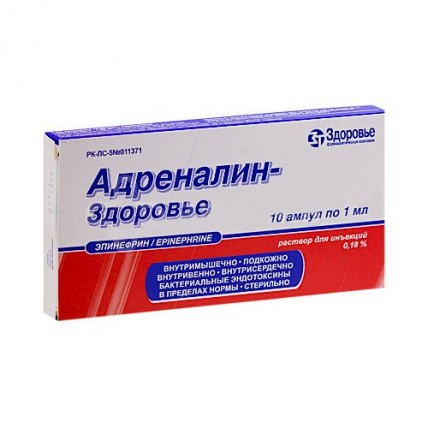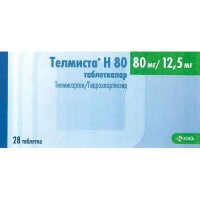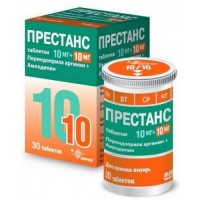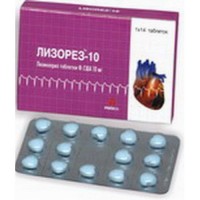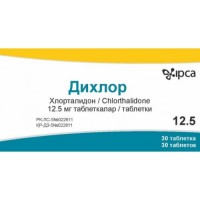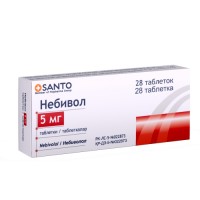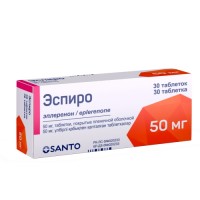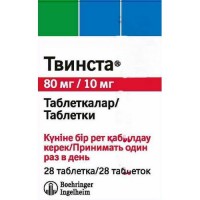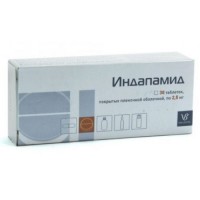Epinephrine Tartrate 0.18%/1 ml, 10 ampoules
- $9.40
Out Of Stock
1 ml of solution contains
Following intramuscular or subcutaneous administration, epinephrine is rapidly absorbed; the maximum concentration in the blood is reached after 3-10 minutes.
The therapeutic effect develops almost instantly with intravenous administration (duration of action - 1-2 minutes), 5-10 minutes after subcutaneous administration (maximum effect - after 20 minutes), with intramuscular administration, the onset of the effect is variable.
Penetrates through the placental barrier, into breast milk, does not penetrate the blood-brain barrier.
It is metabolized by monoamine oxidase (to vanillylmandelic acid) and catechol-O-methyltransferase (to metanephrine) in the cells of the liver, kidneys, intestinal mucosa, and axons.
The elimination half-life for intravenous administration is 1-2 minutes. Excretion of metabolites is carried out by the kidneys. It is allocated with breast milk.
Adrenaline-Health is a cardiostimulating, vasoconstrictor, hypertensive, antihypoglycemic agent. Stimulates α- and β-adrenergic receptors of various localization. It has a pronounced effect on the smooth muscles of internal organs, the cardiovascular and respiratory systems, activates carbohydrate and lipid metabolism.
The mechanism of action is due to the activation of adenylate cyclase on the inner surface of cell membranes, an increase in the intracellular concentration of cAMP and Ca2+. The first phase of action is primarily due to stimulation of β-adrenergic receptors of various organs and is manifested by tachycardia, increased cardiac output, excitability and conduction of the myocardium, arteriolo- and bronchodilation, decreased uterine tone, mobilization of glycogen from the liver and fatty acids from fatty depots. In the second phase, excitation of α-adrenergic receptors occurs, which leads to vasoconstriction of the abdominal organs, skin, mucous membranes (skeletal muscles - to a lesser extent), an increase in blood pressure (mainly systolic), and total peripheral vascular resistance.
The effectiveness of the drug depends on the dose. At very low doses, at an administration rate of less than 0.01 mcg/kg/min, it may lower blood pressure due to skeletal muscle vasodilatation. At an injection rate of 0.04-0.1 µg/kg/min, it increases the frequency and strength of heart contractions, stroke volume and minute blood volume, and reduces the total peripheral vascular resistance; above 0.2 mcg / kg / min - constricts blood vessels, increases blood pressure (mainly systolic) and total peripheral vascular resistance. The pressor effect can cause a short-term reflex slowing of the heart rate. Relaxes the smooth muscles of the bronchi. Doses above 0.3 μg / kg / min reduce renal blood flow, blood supply to internal organs, tone and motility of the gastrointestinal tract.
Increases conductivity, excitability and automatism of the myocardium. Increases myocardial oxygen demand. It inhibits the release of histamine and leukotrienes induced by antigens, eliminates spasm of bronchioles, and prevents the development of edema of their mucous membrane. Acting on α-adrenergic receptors of the skin, mucous membranes and internal organs, it causes vasoconstriction, a decrease in the rate of absorption of local anesthetics, increases the duration of action and reduces the toxic effect of local anesthesia. Stimulation of β2-adrenergic receptors is accompanied by increased excretion of potassium from the cell and can lead to hypokalemia. With intracavernous administration, it reduces the blood filling of the cavernous bodies.
It dilates the pupils, helps to reduce the production of intraocular fluid and intraocular pressure. It causes hyperglycemia (increases glycogenolysis and gluconeogenesis) and increases the content of free fatty acids in the blood plasma, improves tissue metabolism. Weakly stimulates the central nervous system, exhibits anti-allergic and anti-inflammatory effects.
- allergic reactions of immediate type: anaphylactic shock that developed during the use of drugs, serums, blood transfusions, insect bites or contact with allergens
- relief of acute attacks of bronchial asthma
- arterial hypotension of various origins (posthemorrhagic, intoxication, infectious)
- hypokalemia, including due to an overdose of insulin
- asystole, cardiac arrest
- prolonging the action of local anesthetics
- AV blockade of the III degree, acutely developed
Assign intramuscularly, subcutaneously, intravenously (drip), intracardiac (resuscitation during cardiac arrest). When administered intramuscularly, the effect of the drug develops faster than when administered subcutaneously. Dosing regimen is individual.
Adults.
Anaphylactic shock: 0.5 ml is slowly injected intravenously, diluted in 20 ml of 40% glucose solution. In the future, if necessary, continue intravenous drip at a rate of 1 μg / min, for which 1 ml of adrenaline solution is dissolved in 400 ml of isotonic sodium chloride or 5% glucose. If the patient's condition allows, it is better to carry out intramuscular or subcutaneous administration of 0.3-0.5 ml diluted or undiluted.
Bronchial asthma: injected subcutaneously 0.3-0.5 ml diluted or undiluted. If repeated administration is necessary, this dose can be administered every 20 minutes (up to 3 times). Perhaps intravenous administration of 0.3-0.5 ml diluted.
As a vasoconstrictor, it is administered intravenously at a rate of 1 μg / min (with a possible increase to 2-10 μg / min).
Asystole: administered intracardiac 0.5 ml, diluted in 10 ml of 0.9% sodium chloride solution. During resuscitation - 1 ml (diluted) intravenously slowly every 3-5 minutes.
Children.
Asystole in newborns: injected intravenously at 0.01 ml / kg of body weight every 3-5 minutes, slowly.
Anaphylactic shock: administered subcutaneously or intramuscularly to children under the age of 1 year - 0.05 ml, at the age of 1 year - 0.1 ml, 2 years - 0.2 ml, 3-4 years - 0.3 ml, 5 years - 0.4 ml, 6-12 years old - 0.5 ml. If necessary, the introduction is repeated every 15 minutes (up to 3 times).
Bronchospasm: injected subcutaneously 0.01 ml / kg of body weight (maximum - up to 0.3 ml). If necessary, the introduction is repeated every 15 minutes (up to 3-4 times) or every 4 hours.
Often:
- headache
- anxiety state
- tremor
- nausea, vomiting
- anorexia
- hyperglycemia
Infrequently:
- angina pectoris, bradycardia or tachycardia, palpitations, decrease or increase in blood pressure (even with subcutaneous administration in normal doses, subarachnoid hemorrhage and hemiplegia are possible due to an increase in blood pressure)
- shortness of breath
- nervousness, dizziness, fatigue, sleep disturbance
- muscle twitches
- psychoneurotic disorders (psychomotor agitation, disorientation)
- memory impairment
- aggressive or panicky behavior
- schizophrenia-like disorders, paranoia
- increased rigidity and tremor (in patients with Parkinson's disease)
- angioedema, bronchospasm
- skin rash, erythema multiforme
- increased sweating, impaired thermoregulation, cold extremities
Rarely:
- ventricular arrhythmias, chest pain
- ECG changes (including decreased T-wave amplitude)
- difficult and painful urination (with prostatic hyperplasia)
- hypokalemia
- pulmonary edema
- pain or burning at the site of intramuscular injection, with repeated injections of adrenaline, necrosis may occur due to the vasoconstrictive action of adrenaline
- increased individual sensitivity to the components of the drug
- hypertrophic obstructive cardiomyopathy
- severe aortic stenosis
- tachyarrhythmia, ventricular fibrillation
- arterial or pulmonary hypertension
- ischemic pulmonary disease
- severe atherosclerosis
- occlusive vascular disease
- pheochromocytoma
- angle-closure glaucoma
- non-allergenic shock
- convulsive syndrome
- thyrotoxicosis
- diabetes
- general anesthesia with the use of inhalants: halothane, cyclopropane, chloroform
- period of pregnancy and lactation, II period of childbirth
- application on the areas of the fingers and toes, on the areas of the nose, genitals
Epinephrine antagonists are α- and β-adrenergic blockers.
With the simultaneous use of the drug Adrenaline-Health with other drugs, it is possible:
- with narcotic analgesics and sleeping pills - weakening their effects;
- with cardiac glycosides, quinidine, tricyclic antidepressants, dopamine, inhalation anesthesia agents (chloroform, enflurane, halothane, isoflurane, methoxyflurane), cocaine - increased risk of arrhythmias;
- with other sympathomimetic agents - increased severity of side effects from the cardiovascular system;
- with antihypertensive drugs (including diuretics) - a decrease in their effectiveness;
- with monoamine oxidase inhibitors (including furazolidone, procarbazine, selegiline) - sudden and pronounced increase in blood pressure, hyperpyretic crisis, headache, cardiac arrhythmias, vomiting;
- with nitrates - weakening of their therapeutic effect;
- with phenoxybenzamine - increased hypotensive effect and tachycardia;
- with phenytoin - a sudden decrease in blood pressure and bradycardia, depending on the dose and rate of administration of adrenaline;
- with preparations of thyroid hormones - mutual enhancement of action;
- with astemizole, cisapride, terfenadine - prolongation of the QT interval on the ECG;
- with diatrizoatams, iothalamic or ioxagloic acids - increased neurological effects;
- with ergot alkaloids - increased vasoconstrictor effect up to severe ischemia and development of gangrene;
- with hypoglycemic drugs (including insulin) - reduction of the hypoglycemic effect;
- with non-depolarizing muscle relaxants - a decrease in the muscle relaxant effect is possible;
- with hormonal contraceptives - may reduce effectiveness.
It is administered intracardiac for asystole, if other methods of its elimination are not available, while there is an increased risk of developing cardiac tamponade and pneumothorax.
If an infusion is required, a device with a measuring device should be used to control the rate of infusion. Infusion should be carried out in a large, preferably in the central vein. During the infusion, it is recommended to monitor the concentration of potassium in the blood serum, blood pressure, diuresis, ECG, central venous pressure, pressure in the pulmonary artery.
The use of the drug in diabetic patients increases glycemia, and therefore requires higher doses of insulin or sulfonylurea derivatives.
It is undesirable to use adrenaline for a long time, since the narrowing of peripheral vessels can lead to the development of necrosis or gangrene.
When stopping treatment, the dose of epinephrine should be reduced gradually, since sudden withdrawal of therapy can lead to severe hypotension.
With caution appoint patients with ventricular arrhythmia, coronary heart disease, atrial fibrillation, arterial hypertension, pulmonary hypertension, myocardial infarction (if it becomes necessary to use the drug for myocardial infarction, remember that adrenaline can increase ischemia by increasing myocardial oxygen demand) , metabolic acidosis, hypercapnia, hypoxia, hypovolemia, thyrotoxicosis, in patients with occlusive vascular diseases (arterial embolism, atherosclerosis, Buerger's disease, cold injury, diabetic endarteritis, Raynaud's disease, with cerebral atherosclerosis, Parkinson's disease, with convulsive syndrome, with prostatic hypertrophy glands.
In case of hypovolemia, patients should be adequately hydrated before using sympathomimetics.
Application in pediatrics .
Special care should be taken when administering the drug to children (dosing is different). Recommendations for dosing the drug to children are given in the section "Method of application and doses" .
Use during pregnancy and lactation
Do not use during childbirth to correct hypotension, since the drug may delay the second stage of labor by relaxing the muscles of the uterus. When administered in large doses to weaken uterine contractions, it can cause prolonged atony of the uterus with bleeding.
If necessary, the use of the drug should stop breastfeeding, as there is a high likelihood of side effects in the child.
Features of the effect of the drug on the ability to drive vehicles and work with complex mechanisms.
During the period of treatment with the drug, it is not recommended to drive vehicles and engage in other potentially hazardous activities that require an increased concentration of attention and speed of psychomotor reactions.
Symptoms: excessive increase in blood pressure, mydriasis, tachyarrhythmia, followed by bradycardia, heart rhythm disturbance (including atrial and ventricular fibrillation), coldness and pallor of the skin, vomiting, fear, anxiety, tremor, headache, metabolic acidosis, myocardial infarction, craniocerebral hemorrhage (especially in elderly patients), pulmonary edema, renal failure.
Treatment: discontinuation of the drug. Symptomatic therapy, the use of α- and β-blockers, fast-acting nitrates. With arrhythmia, parenteral administration of β-blockers (propranolol) is prescribed.
Store in a place protected from light, at a temperature of 8 0C to 15 0C.
Keep out of the reach of children!
Shelf life - 2 years
Do not use the drug after the expiration date indicated on the package!
- active ingredient - adrenaline hydrotartrate 1.82 mg
- excipients: sodium metabisulphite (E 223), sodium chloride, water for injection
Pharmacological properties
Pharmacokinetics
Following intramuscular or subcutaneous administration, epinephrine is rapidly absorbed; the maximum concentration in the blood is reached after 3-10 minutes.
The therapeutic effect develops almost instantly with intravenous administration (duration of action - 1-2 minutes), 5-10 minutes after subcutaneous administration (maximum effect - after 20 minutes), with intramuscular administration, the onset of the effect is variable.
Penetrates through the placental barrier, into breast milk, does not penetrate the blood-brain barrier.
It is metabolized by monoamine oxidase (to vanillylmandelic acid) and catechol-O-methyltransferase (to metanephrine) in the cells of the liver, kidneys, intestinal mucosa, and axons.
The elimination half-life for intravenous administration is 1-2 minutes. Excretion of metabolites is carried out by the kidneys. It is allocated with breast milk.
Pharmacodynamics
Adrenaline-Health is a cardiostimulating, vasoconstrictor, hypertensive, antihypoglycemic agent. Stimulates α- and β-adrenergic receptors of various localization. It has a pronounced effect on the smooth muscles of internal organs, the cardiovascular and respiratory systems, activates carbohydrate and lipid metabolism.
The mechanism of action is due to the activation of adenylate cyclase on the inner surface of cell membranes, an increase in the intracellular concentration of cAMP and Ca2+. The first phase of action is primarily due to stimulation of β-adrenergic receptors of various organs and is manifested by tachycardia, increased cardiac output, excitability and conduction of the myocardium, arteriolo- and bronchodilation, decreased uterine tone, mobilization of glycogen from the liver and fatty acids from fatty depots. In the second phase, excitation of α-adrenergic receptors occurs, which leads to vasoconstriction of the abdominal organs, skin, mucous membranes (skeletal muscles - to a lesser extent), an increase in blood pressure (mainly systolic), and total peripheral vascular resistance.
The effectiveness of the drug depends on the dose. At very low doses, at an administration rate of less than 0.01 mcg/kg/min, it may lower blood pressure due to skeletal muscle vasodilatation. At an injection rate of 0.04-0.1 µg/kg/min, it increases the frequency and strength of heart contractions, stroke volume and minute blood volume, and reduces the total peripheral vascular resistance; above 0.2 mcg / kg / min - constricts blood vessels, increases blood pressure (mainly systolic) and total peripheral vascular resistance. The pressor effect can cause a short-term reflex slowing of the heart rate. Relaxes the smooth muscles of the bronchi. Doses above 0.3 μg / kg / min reduce renal blood flow, blood supply to internal organs, tone and motility of the gastrointestinal tract.
Increases conductivity, excitability and automatism of the myocardium. Increases myocardial oxygen demand. It inhibits the release of histamine and leukotrienes induced by antigens, eliminates spasm of bronchioles, and prevents the development of edema of their mucous membrane. Acting on α-adrenergic receptors of the skin, mucous membranes and internal organs, it causes vasoconstriction, a decrease in the rate of absorption of local anesthetics, increases the duration of action and reduces the toxic effect of local anesthesia. Stimulation of β2-adrenergic receptors is accompanied by increased excretion of potassium from the cell and can lead to hypokalemia. With intracavernous administration, it reduces the blood filling of the cavernous bodies.
It dilates the pupils, helps to reduce the production of intraocular fluid and intraocular pressure. It causes hyperglycemia (increases glycogenolysis and gluconeogenesis) and increases the content of free fatty acids in the blood plasma, improves tissue metabolism. Weakly stimulates the central nervous system, exhibits anti-allergic and anti-inflammatory effects.
Indications for use
- allergic reactions of immediate type: anaphylactic shock that developed during the use of drugs, serums, blood transfusions, insect bites or contact with allergens
- relief of acute attacks of bronchial asthma
- arterial hypotension of various origins (posthemorrhagic, intoxication, infectious)
- hypokalemia, including due to an overdose of insulin
- asystole, cardiac arrest
- prolonging the action of local anesthetics
- AV blockade of the III degree, acutely developed
Dosage and administration
Assign intramuscularly, subcutaneously, intravenously (drip), intracardiac (resuscitation during cardiac arrest). When administered intramuscularly, the effect of the drug develops faster than when administered subcutaneously. Dosing regimen is individual.
Adults.
Anaphylactic shock: 0.5 ml is slowly injected intravenously, diluted in 20 ml of 40% glucose solution. In the future, if necessary, continue intravenous drip at a rate of 1 μg / min, for which 1 ml of adrenaline solution is dissolved in 400 ml of isotonic sodium chloride or 5% glucose. If the patient's condition allows, it is better to carry out intramuscular or subcutaneous administration of 0.3-0.5 ml diluted or undiluted.
Bronchial asthma: injected subcutaneously 0.3-0.5 ml diluted or undiluted. If repeated administration is necessary, this dose can be administered every 20 minutes (up to 3 times). Perhaps intravenous administration of 0.3-0.5 ml diluted.
As a vasoconstrictor, it is administered intravenously at a rate of 1 μg / min (with a possible increase to 2-10 μg / min).
Asystole: administered intracardiac 0.5 ml, diluted in 10 ml of 0.9% sodium chloride solution. During resuscitation - 1 ml (diluted) intravenously slowly every 3-5 minutes.
Children.
Asystole in newborns: injected intravenously at 0.01 ml / kg of body weight every 3-5 minutes, slowly.
Anaphylactic shock: administered subcutaneously or intramuscularly to children under the age of 1 year - 0.05 ml, at the age of 1 year - 0.1 ml, 2 years - 0.2 ml, 3-4 years - 0.3 ml, 5 years - 0.4 ml, 6-12 years old - 0.5 ml. If necessary, the introduction is repeated every 15 minutes (up to 3 times).
Bronchospasm: injected subcutaneously 0.01 ml / kg of body weight (maximum - up to 0.3 ml). If necessary, the introduction is repeated every 15 minutes (up to 3-4 times) or every 4 hours.
Side effects
Often:
- headache
- anxiety state
- tremor
- nausea, vomiting
- anorexia
- hyperglycemia
Infrequently:
- angina pectoris, bradycardia or tachycardia, palpitations, decrease or increase in blood pressure (even with subcutaneous administration in normal doses, subarachnoid hemorrhage and hemiplegia are possible due to an increase in blood pressure)
- shortness of breath
- nervousness, dizziness, fatigue, sleep disturbance
- muscle twitches
- psychoneurotic disorders (psychomotor agitation, disorientation)
- memory impairment
- aggressive or panicky behavior
- schizophrenia-like disorders, paranoia
- increased rigidity and tremor (in patients with Parkinson's disease)
- angioedema, bronchospasm
- skin rash, erythema multiforme
- increased sweating, impaired thermoregulation, cold extremities
Rarely:
- ventricular arrhythmias, chest pain
- ECG changes (including decreased T-wave amplitude)
- difficult and painful urination (with prostatic hyperplasia)
- hypokalemia
- pulmonary edema
- pain or burning at the site of intramuscular injection, with repeated injections of adrenaline, necrosis may occur due to the vasoconstrictive action of adrenaline
Contraindications
- increased individual sensitivity to the components of the drug
- hypertrophic obstructive cardiomyopathy
- severe aortic stenosis
- tachyarrhythmia, ventricular fibrillation
- arterial or pulmonary hypertension
- ischemic pulmonary disease
- severe atherosclerosis
- occlusive vascular disease
- pheochromocytoma
- angle-closure glaucoma
- non-allergenic shock
- convulsive syndrome
- thyrotoxicosis
- diabetes
- general anesthesia with the use of inhalants: halothane, cyclopropane, chloroform
- period of pregnancy and lactation, II period of childbirth
- application on the areas of the fingers and toes, on the areas of the nose, genitals
Drug Interactions
Epinephrine antagonists are α- and β-adrenergic blockers.
With the simultaneous use of the drug Adrenaline-Health with other drugs, it is possible:
- with narcotic analgesics and sleeping pills - weakening their effects;
- with cardiac glycosides, quinidine, tricyclic antidepressants, dopamine, inhalation anesthesia agents (chloroform, enflurane, halothane, isoflurane, methoxyflurane), cocaine - increased risk of arrhythmias;
- with other sympathomimetic agents - increased severity of side effects from the cardiovascular system;
- with antihypertensive drugs (including diuretics) - a decrease in their effectiveness;
- with monoamine oxidase inhibitors (including furazolidone, procarbazine, selegiline) - sudden and pronounced increase in blood pressure, hyperpyretic crisis, headache, cardiac arrhythmias, vomiting;
- with nitrates - weakening of their therapeutic effect;
- with phenoxybenzamine - increased hypotensive effect and tachycardia;
- with phenytoin - a sudden decrease in blood pressure and bradycardia, depending on the dose and rate of administration of adrenaline;
- with preparations of thyroid hormones - mutual enhancement of action;
- with astemizole, cisapride, terfenadine - prolongation of the QT interval on the ECG;
- with diatrizoatams, iothalamic or ioxagloic acids - increased neurological effects;
- with ergot alkaloids - increased vasoconstrictor effect up to severe ischemia and development of gangrene;
- with hypoglycemic drugs (including insulin) - reduction of the hypoglycemic effect;
- with non-depolarizing muscle relaxants - a decrease in the muscle relaxant effect is possible;
- with hormonal contraceptives - may reduce effectiveness.
Special instructions
It is administered intracardiac for asystole, if other methods of its elimination are not available, while there is an increased risk of developing cardiac tamponade and pneumothorax.
If an infusion is required, a device with a measuring device should be used to control the rate of infusion. Infusion should be carried out in a large, preferably in the central vein. During the infusion, it is recommended to monitor the concentration of potassium in the blood serum, blood pressure, diuresis, ECG, central venous pressure, pressure in the pulmonary artery.
The use of the drug in diabetic patients increases glycemia, and therefore requires higher doses of insulin or sulfonylurea derivatives.
It is undesirable to use adrenaline for a long time, since the narrowing of peripheral vessels can lead to the development of necrosis or gangrene.
When stopping treatment, the dose of epinephrine should be reduced gradually, since sudden withdrawal of therapy can lead to severe hypotension.
With caution appoint patients with ventricular arrhythmia, coronary heart disease, atrial fibrillation, arterial hypertension, pulmonary hypertension, myocardial infarction (if it becomes necessary to use the drug for myocardial infarction, remember that adrenaline can increase ischemia by increasing myocardial oxygen demand) , metabolic acidosis, hypercapnia, hypoxia, hypovolemia, thyrotoxicosis, in patients with occlusive vascular diseases (arterial embolism, atherosclerosis, Buerger's disease, cold injury, diabetic endarteritis, Raynaud's disease, with cerebral atherosclerosis, Parkinson's disease, with convulsive syndrome, with prostatic hypertrophy glands.
In case of hypovolemia, patients should be adequately hydrated before using sympathomimetics.
Application in pediatrics .
Special care should be taken when administering the drug to children (dosing is different). Recommendations for dosing the drug to children are given in the section "Method of application and doses" .
Use during pregnancy and lactation
Do not use during childbirth to correct hypotension, since the drug may delay the second stage of labor by relaxing the muscles of the uterus. When administered in large doses to weaken uterine contractions, it can cause prolonged atony of the uterus with bleeding.
If necessary, the use of the drug should stop breastfeeding, as there is a high likelihood of side effects in the child.
Features of the effect of the drug on the ability to drive vehicles and work with complex mechanisms.
During the period of treatment with the drug, it is not recommended to drive vehicles and engage in other potentially hazardous activities that require an increased concentration of attention and speed of psychomotor reactions.
Overdose
Symptoms: excessive increase in blood pressure, mydriasis, tachyarrhythmia, followed by bradycardia, heart rhythm disturbance (including atrial and ventricular fibrillation), coldness and pallor of the skin, vomiting, fear, anxiety, tremor, headache, metabolic acidosis, myocardial infarction, craniocerebral hemorrhage (especially in elderly patients), pulmonary edema, renal failure.
Treatment: discontinuation of the drug. Symptomatic therapy, the use of α- and β-blockers, fast-acting nitrates. With arrhythmia, parenteral administration of β-blockers (propranolol) is prescribed.
Storage conditions
Store in a place protected from light, at a temperature of 8 0C to 15 0C.
Keep out of the reach of children!
Shelf life - 2 years
Do not use the drug after the expiration date indicated on the package!
